Allison Bruning's Blog, page 30
February 23, 2014
#Author Spotlight: Aya Walksfar Exposes Human Trafficking

My guest for today is author Aya Walksfar. Aya brings to the Author's Spotlight today the second book of her Special Crimes Team series, Street Harvest. Street Harvest takes the members of the Special Crimes Team into the world of human trafficking.
IN THE WORDS OF AYA WALKSFAR
There are few things more terrifying than a missing child, yet in the United States a child goes missing every 40 seconds. Many are never reported as missing. They become the street kids who hang on the corner, stealing food from the local supermarket, panhandling and selling their bodies for one night of a warm bed and food in their stomachs.
Other children who vanish have families who grieve them, miss them, and may never see them alive again. Human trafficking is a multi-billion dollar per year business and many of the lives that it consumes are children who have gone missing.
I have known some of these children, have worked with them on the streets of Seattle, have taken a few of them into my home. Some have run away from abusive families; some are seeking adventure and instead find terror, abuse and drugs; some are kicked out because they are lesbian or gay, transgender or bisexual. One thing they all have in common: they are at high risk to become prey for sexual predators.
Street Harvest presents the story behind the headlines. Through the fictional account of a case, I hope to enlighten others to the reality. We are the only ones who can change that reality, but we can’t change what we don’t know about. I want to encourage people to see themselves in Auntie El’s outstretched hand, in Jaimie Wolfwalker’s determination to find the children, in the dedication of the police to bring those children safely home.
This is the reality: children disappear and are never seen again.
AN EPILOGUE FROM REALITY
 A child is missing when it falls off the “normal radar,” such as the school or foster care system, or when a parent or guardian no longer knows where that child is, and law enforcement cannot locate that child.
A child is missing when it falls off the “normal radar,” such as the school or foster care system, or when a parent or guardian no longer knows where that child is, and law enforcement cannot locate that child.In the United States, the Office of Juvenile Justice and Delinquency Prevention estimates that a child goes missing every 40 seconds. The National Center for Missing and Exploited Children estimates that roughly 2,000 children in the United States go missing every day, a country that professes to love its children and to take care of them.
In the State of Washington alone, the Missing Children Clearinghouse estimates that over 20,000 children per year go missing. According to Washington State Missing Children “Dozens of children go missing from Washington State and most of them don’t get an Amber Alert.” Also, in Washington State as of December 2013, there are over 354 children still on the Missing Children’s List after five to ten years of being gone.
A child goes missing for a variety of reasons.
1. Runaway: these children leave home oftentimes due to intolerable abuse. Without skills, education
or money, these children fall easy prey to prostitution, sexual predation, pornography, and human trafficking.
2. Thrown Away: these children are kicked out of their homes for a variety of reasons; many are thrown away because they are LGBTQ (Lesbian, Gay, Bisexual, Transgender, and Questioning) children. Born different, discarded young.
According to Zack Ford in an article posted by thinkprogress.org and dated July 12, 2012, as many as 40 percent of homeless youth identify as LGBT.
All street children are at risk for exploitation through prostitution, sexual tourism, pornography, human trafficking.
3. Human Trafficking:
The State of Washington is a good example of what law enforcement faces in trying to halt human trafficking. According to a report from the State of Washington's Task Force against Trafficking of Persons reports, “our state is a hotbed for the recruitment, transportation, and sale of people for labor. The report indicates several factors make Washington prone to human trafficking:
• International border with Canada
• Abundance of ports
• Vast rural areas
• Dependency on agricultural workers
Seattle is part of a trafficking circuit that can include Honolulu, Las Vegas, New Orleans, Portland, Vancouver (Clark County), Yakima, and Canada.
The report also notes that trafficking has occurred in 18 Washington State counties.
• Victims range from "mail-order" brides to sex workers to domestic workers and children.
Local victims have come as far as Russia, the Philippines, China, and Mexico.
There are a number of destinations for children taken by human traffickers:
a. Sexual Tourism, which occurs in many different countries and for which countries import kidnapped children to satisfy the demand. This demand is frequently due to the perverted appetites of men from developed countries; brothels, and street prostitution.
b. Pornography, which includes a wide range of films—in some of which the child is murdered for sexual gratification of the potential audience; audiotapes, and still photographs. An article in Wikipedia from the report “Commercial Sexual Exploitation of Children” states that child pornography is a multi-billion dollar per year industry.
c. Body Parts. We hate to consider it, but children are harvested for body parts. According to a report by Missing Children International: “The world we live in is no stranger to one of the biggest reasons many of our children disappear without a trace. Many children are abducted and sold for body parts throughout the United States, Central America, South America, and Europe. The Internet has become one of the greatest sources of business and the organized underground business is one of the most successful businesses anywhere in the world.”
d. Contemporary slavery, which includes sweatshops, field labor, servant type labor, and many other positions as slaves.
e. Breeding, yes this is exactly what it sounds like and includes forced marriages, sometimes of preteens.
4. Abduction: Approximately 58,000 children a year in the United States are abducted. According to a Q13Fox.com article in which Shellee Hale, Founder of Camandago, a private investigations firm that focuses on missing persons: “Unless a witness sees a child being taken, police cannot give the resources and attention of a kidnapping. Many of these kids vanished without a trace. Even high-profile cases are still unsolved with no leads. But as we’ve seen over and over again, it’s not impossible for these missing kids to resurface after months or even years.” (This is an excerpt. For the full article, please go to Q13Fox.com.) Children are kidnapped for a number of reasons:
Ransom: a child is taken to extract a set amount of money or favor from the parent or guardian.
Sexual Predation: a child is taken, raped, sometimes tortured, sometimes murdered.
Illegal Adoptions
5. Custodial Disputes: The non-custodial parent disappears with the child; sometimes, neither is ever again located.
6. Non-Stranger Abduction: this could be an aunt, uncle, other relative, or a boyfriend/girlfriend of the parent, a babysitter, anyone who is known to the child. These kidnappers often feel they are “in love with the child,” or that “they love the child more than the parent does.” This can be sexual or non-sexual relationships.
7. Murder: accidental or intentional
Key findings: Washington State Attorney General: 2006 Child Abduction Murder Study
The use of pornography by killers as a trigger to murder has increased.
• In 74 percent of the missing children homicide cases studied, the child murder victim was female and the average age was 11 years old.
• In 44 percent of the cases studied, the victims and killers were strangers, but in 42 percent of the cases, the victims and killers were friends or acquaintances.
• Only about 14 percent of the cases studied involved parents or intimates killing the child.
• Almost two-thirds of the killers in these cases have prior arrests for violent crimes, with slightly more than half of those prior crimes committed against children.
• The primary motive for the child abduction killer in the cases studied was sexual assault.
• In nearly 60 percent of the cases studied, more than two hours passed between the time someone realized the child was missing and the time police were notified.
• In 76 percent of the missing children homicide cases studied, the child was dead within three hours of the abduction–and in 88.5 percent of the cases the child was dead within 24 hours.
 I write novels, fictional accounts of situations. What you have read here is REALITY. A missing child is a child in grave danger. What are we, in the United States, going to do about our missing children?
I write novels, fictional accounts of situations. What you have read here is REALITY. A missing child is a child in grave danger. What are we, in the United States, going to do about our missing children?Remember:
40% of street children are LGBT
In the United States on any given day over 2,000 children will go missing.
Human traffickers prey on children.
Street children are among the missing children, and are at grave risk.
It is up to us to FIND the children, and to bring them safely home.
STREET HARVEST BY AYA WALKSFAR
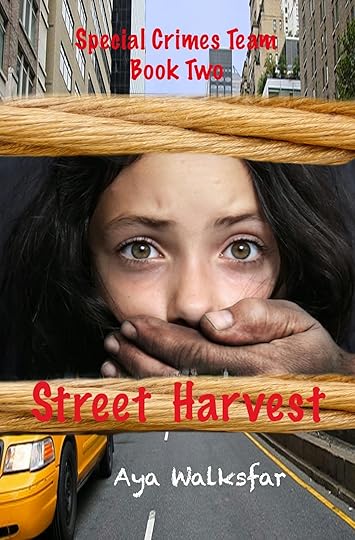 What do the bodies of two young children have in common with the murders of two adult men? Eleanor Hasting, a black bookstore owner and child advocate, knows these killings are linked. How can she convince Lieutenant Michael Williams, head of the Special Crimes Team? Someone is abducting street children and their bodies are showing up sexually abused and manually strangled. Psychic and member of Missing Children's Rescue, Jaimie Wolfwalker, is prepared to do whatever it takes to locate and rescue the missing street children. The law be damned. Jaimie's attitude and methods place her on a collision course with Sergeant Nita Slowater, second-in-command of the Special Crimes Team. Four dedicated people struggle to come to terms with each other in their desperate search for clues. Every day brings more missing children, more young bodies. Can they stop the monsters before another child disappears? http://amzn.to/1fsZR0f
What do the bodies of two young children have in common with the murders of two adult men? Eleanor Hasting, a black bookstore owner and child advocate, knows these killings are linked. How can she convince Lieutenant Michael Williams, head of the Special Crimes Team? Someone is abducting street children and their bodies are showing up sexually abused and manually strangled. Psychic and member of Missing Children's Rescue, Jaimie Wolfwalker, is prepared to do whatever it takes to locate and rescue the missing street children. The law be damned. Jaimie's attitude and methods place her on a collision course with Sergeant Nita Slowater, second-in-command of the Special Crimes Team. Four dedicated people struggle to come to terms with each other in their desperate search for clues. Every day brings more missing children, more young bodies. Can they stop the monsters before another child disappears? http://amzn.to/1fsZR0fWHO IS AYA WALKSFAR?
 Aya's illiterate grandfather and nearly-illiterate grandmother conspired to teach her to read and write by age six, and succeeded with the help of a Carnegie librarian.
Aya's illiterate grandfather and nearly-illiterate grandmother conspired to teach her to read and write by age six, and succeeded with the help of a Carnegie librarian.Since then writing has been Aya's all-consuming passion. "Words give us wings to soar above our circumstances, no matter how violent or poverty-stricken," Aya says. "I became a writer because I want to share the magic of words."
Once the novel is published, she makes a commitment to her readers: “I have created women and men
you will never forget; people you will laugh and cry with. I will appreciate and listen to your feedback, both positive and critical. I appreciate you, my reader.”
Aya draws from a vast array of experiences. She has represented people in committee hearings in front of members of the House of Representatives of California; she has lived on the road and eaten at soup kitchens; she has farmed, been a mechanic, worked in construction, been a waitress; she has been a personal guard for children who were under threats of violence.
Aya graduated from the University of Washington’s Writer’s Course. For a number of years she worked as a counselor and studied human nature.
Aya is passionate about changing the image of women in the media. "It is time for women to read about strong women who positively impact their worlds; who are the rescuers, rather than being the ones who must be rescued. This is why I write books with strong female characters, and strong, caring male characters."
Aya currently lives in the shadows of the Pacific Northwest mountains. She and her wife, Deva, own a 12-acre wildlife/wild bird habitat. When she isn’t writing, Aya loves to read, hike, work with her German Shepherd dogs, tend the land, ride her motorcycle, and spend time with her family and friends.
In 2013, Aya published three books:
Sketch of a Murder, Book 1, Special Crimes Team: Misfits and Loners, this team has to stop The Avenger’s murder spree.
Good Intentions, winner of Alice B. Reader Award 2002: Bev Ransom has a secret; so does the rest of her family.
Dead Men and Cats, novella: What do dead men and dead cats have in common
Published on February 23, 2014 06:24
February 22, 2014
#Author Spotlight: A New Feature For All Authors

Welcome to a new section on my blog. Every weekend I will be presenting you authors talking about their new releases. You'll never know who might show up in the spotlight. If you would like to be spotted please email me allisonbruning@gmail.com. I will be posting spotlights every Friday, Saturday and Sunday. It's my plan to have three authors per week. Authors: If you are spotted be sure to grab your badge and post it on your blog or website with a link to your spotlight. Here's the badge.
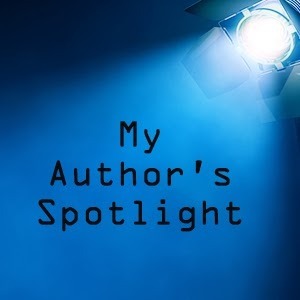
Join me tomorrow as I feature Aya Walksfar and her new book, Street Harvest (Special Crimes Team: Book 2)
Published on February 22, 2014 13:27
February 21, 2014
Celebrate the Small Stuff #blessings #Valentine'sDay
 Celebrate the Small Things
Celebrate the Small ThingsBlog Hop
I recently came across this blog hop while I was reading some of my favorite blogs. Sometimes we can get so dragged down by the negatives in our life that we forget the acknowledge, let alone celebrate, the small blessings in our lives. Authors have always been sensitive and that's why it's very important for us to focus on the positives. When we focus on the negatives of our lives we damper our own creative energy. We can create our own writing block. I want to thank the owner of Scribblings of an Aspiring Author for creating this weekly blog hop.
This week my small blessing was a delayed Valentine's Day date. My husband and I were unable to go out on a date for Valentine's Day due to the weather. We had a mini date yesterday. We ordered Chinese for dinner and had Baskin Robbins for dessert. It was so wonderful!
What was a small blessing you had this week?
Published on February 21, 2014 05:20
February 20, 2014
#Ireland Through Time: Glacial Ireland
 Public DomainThe Emerald Isle Through Time: Glacial IrelandWelcome to my series The Emerald Isle Through Time. Ireland has been occupied since 8000 BC and her people have a rich, vibrant cultural heritage that has been threatened many times through a series of invasions. Cultural changes often occur when one society interacts with another. This has been true for the Irish people. This series will explore those cultural changes and how they affected the native Irish people.
Public DomainThe Emerald Isle Through Time: Glacial IrelandWelcome to my series The Emerald Isle Through Time. Ireland has been occupied since 8000 BC and her people have a rich, vibrant cultural heritage that has been threatened many times through a series of invasions. Cultural changes often occur when one society interacts with another. This has been true for the Irish people. This series will explore those cultural changes and how they affected the native Irish people.The beautiful picture to the left is a familiar image to most people. It was taken by NASA and shows the why Ireland is commonly referred to as the Emerald Isle. Yet Ireland wasn't always an island.
The Pleistocene Epoch, most commonly know as the Last Ice Age, lasted from 2,588,000 to 11,700 years ago. During this time, Ireland was attached to the European continent. Before the Ice Age, Ireland shared a lush landscape full of tall mountains and forests with France. Neanderthals and Homo Sapiens dwelt in the area around 40,000 - 30,000 years ago. Archaeologists have found evidence of their habitation in Scotland and Wales but not in Ireland, although the two islands were connected on the mainland. The two species probably hunted in the Irish area. The first mammals to settle in Ireland was around 48,000 years ago. Ireland had plenty of wildlife to offer. Remains of the Arctic lemming, giant deer, reindeer and brown bear from 32,000 years ago have been found in Ireland. There is evidence of the Mammoth roaming the Irish countryside but the giant elephant had disappeared from the area before humans arrived.
Humans and most of the wildlife left the area when the glaciers arrived from Scandinavia around 30,000 years ago. Ice sheets more than 9,800 feet thick pulverized the mountains and reshaped the landscape. Ireland laid under glacial ice for most of the Ice Age.
 http://www.rootsweb.ancestry.com/~irl...
http://www.rootsweb.ancestry.com/~irl...A warmer climate appeared in Europe from 17,500 and 12,000 years ago and the glaciers began to retreat. Ireland's landscape was drastically changed by the glaciers and we owe it's modern shape to this process. Here is a map that shows how Ireland's landscape changed.
 Public Domain
Public DomainAfter the glaciers retreated the sea levels rose so dramatically that part of the Irish coast was flooded. The Irish and North Seas were created. Ireland was left as an Arctic desert or tundra. It's landscape was comprised of badly drained areas with thousands of shallow lakes (3-20 feet deep). As the climate warmed plants would grow along the side of these lakes. When they died they would fall into the lake and the process would repeat. Layers upon layers of plants would stack upon each other. These lakes eventually became the bogs that would later be used by the Irish as a fuel source.
Between 17,500 and 12,000 years ago humans returned to the area from Southern France yet did not settled in Ireland. Humans did not settle in Ireland but they might have used the land as a fishing location. Archaeologists have uncovered a site daring to 13,000 years ago on the eastern side of the Irish Sea that indicates humans in the area were consuming a marine diet.
The landscape was constantly changing as the climate warmed. The new river pattern in Ireland was unlike anything it had ever experienced before. The seas continued to rise at an alarming rate. The sea bridge that connected Ireland and England eventually sunk into the sea around 12,000 years ago. The rising sea levels eventually broke the bond that held Ireland in place 9,500 years ago.
Published on February 20, 2014 06:06
February 18, 2014
Progressive Era #America: #Mentalhealthawareness and discrimination #Aspergers #asylum
Mental Health Discrimination
 Jeb,” Gideon said, taking the doctor by the arm. Doctor Riley lifted his gaze to meet Gideon’s. “What do you plan to do about my son?”
Jeb,” Gideon said, taking the doctor by the arm. Doctor Riley lifted his gaze to meet Gideon’s. “What do you plan to do about my son?”
“Meaning?”
“He’s had a seizure.”
“Yes.”
“He’s already fragile. Will the seizure make his condition worse?”
“Only time can tell.” Gideon lowered his hand, turned his gaze to Franklin and stared. Doctor Riley stepped towards the brown-haired, green-eyed, English-descent man. “Gideon.” Gideon turned his attention to the doctor. “Perhaps it would be best to…”
“…you can stop there, Jeb. Juliette and I told you years ago why we left Upper Sandusky. I will not have the same discussion with you about Franklin I had with both our families. He’s an intelligent boy.”
“I’m not suggesting he isn’t.”
“Franklin will do well to stay where he is. I’ve given him a place at the machine shop designing more inventions. He loves his new office and is doing well overseeing the workers on the floor.”
“Gideon, when are you going to accept Franklin will never be able to run your store? He doesn’t have the social skills to do so. He needs help.”
“He has help,” Juliette answered. The men looked to her. “Franklin has all the help he needs to be successful in life. He doesn’t belong behind an institution’s wall. He’s a mechanical genius, Jeb. He loves tinkering with machines and playing mathematical games. God created our son for a purpose. If we place him within the institution he cannot live a successful and productive life. You’ve been a good friend. I pray the trust we have placed in you will not be forfeited.”
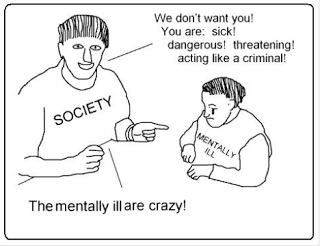
The Progressive Era in the United States occurred from 1890 -1929 and was a movement that began by the children of Civil War veterans. The Progressives wanted to change society from the strict Victorian culture to a more progressive one that would eliminate corruption and inequality. The Progressive Era saw many changes, such as women gaining the right to vote, that have defined a cultural shift in American society. This wasn't the first time Americans had tried to change the Victorian culture. The first Progressive moment, known as the First Reform Era, occurred a few years before the Civil War. It's purpose was reform the treatment of the mentally ill and prisoners. They also wanted to reform working conditions. The reformation was halted when the United States entered the Civil War. The second movement, known as the Progressive Era, began during the Reconstruction Period.
Anthropologically speaking, society is defined as "groups of people who directly or indirectly interact with each other. People in human societies also generally perceive that their society is distinct from other societies in terms of shared traditions and expectations." Anyone who does not accept the norms of their given society, norms being defined as what is normal for a person to say or do in the that given society, is often viewed as an outcast. For example, a person with Aspergers Syndrome does not understand social cues and so when they interact with someone in public they will not act "normal". They will be seen as "being off" or an outcast. Aspergers was not discovered until the 1950's and was not widely known about until the 90's. Before the 1950's anyone who had Aspergers would more than likely find themselves institutionalized because they were deemed mentally ill. Society didn't know how to deal with people who were different than they were so they would lock them away in asylums.
Asylums
The mentally ill have been in society since the beginning of time. Islamic mentally ill had been wonderfully cared for by their people far longer then European society. Europeans did not start to take care of the mentally ill until the Middle Ages when some of the mentally ill population were placed privately in small houses. These houses, and later on asylums, were places where once a person was admitted they rarely saw the light of day and were the victims of many injustices. Living conditions were deplorable and many atrocities occurred with their walls. They were a place where society could get rid of the less desirable and forget about them.
The asylum was supposed to be a place where a mentally ill patient could live for a brief time while receiving the psychiatric help they needed the most. Once they were well they could return to society. Their release was dependent upon a network of psychological professionals who determined whether or not the patient was stable enough to return to society. It sounded like a good idea but sometimes it went terribly wrong. During the Progressive Era the population of the mentally ill in asylums drastically rose. The following chart is from John R. Sutton's 1991 article, The Political Economy of Madness: The Expansion of Asylum in Progressive America in The American Societal Review.
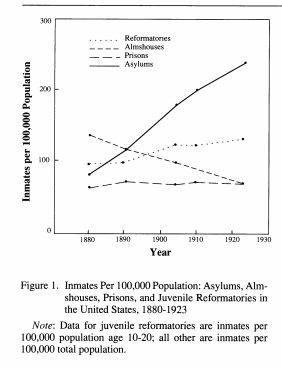 There are four factors that lead to the growth of asylums.
There are four factors that lead to the growth of asylums.
1) Although madness had been medically defined at the beginning of the 19th century it could still be used to place someone in an asylum who was poor, trouble for their family, homeless or had a physical disability.
2) The science of psychiatry was in a weak state. Asylums often times didn't have access to research and their techniques were mainly to create discipline instead of effective methods to help the patient. Instead the patient was subjected to work and discipline procedures that made it easier for the administration to do their work.
3) The medical profession was changing. Asylum administrators continued to operate the asylum as a place of confinement while new psychiatric professionals institutionalize the mentally ill in order to help them.
4) Voluntary organizations, such as the National Association for the Protection of the Insane and Prevention of Insanity, advocated reform while working closely with medical professions who were directly involved with asylums.
The American society during the Progressive Era movement often feared with they didn't understand. The thought of being sent to an asylum was a fate worse than death. The living conditions were deplorable and there were many instances where those committed to the asylum were abused by their guards. Not everyone who was committed to the asylum needed to be there. It was a place of horrors rather healthcare.
In the passage at the top of this blog Franklin, who would have been labeled as having Aspergers Syndrome if this was a modern story, may be institutionalized by his family doctor even though he doesn't need to be there. Why? People fear Franklin because they don't understand him. Fear has driven a lot myths about those who suffer from mental disorders and it is these myths that have harmed those have mental disorders. One of the long held myths about those who have Aspergers Syndrome is "that anyone who has this disorder is highly prone to violence. They are a threat to our society because they do not have feelings nor empathy."
This myth is false. People with Aspergers Syndrome have feelings they just don't always show them. They may appear mean because they don't know empathy but they can learn. One thing about people with Aspergers Syndrome that might surprise you to know is that these people are some of the most caring, loving and sensitive souls you will ever meet. Society is scared of people with Aspergers Syndrome and this is what drives people to discriminate against them.
 Jeb,” Gideon said, taking the doctor by the arm. Doctor Riley lifted his gaze to meet Gideon’s. “What do you plan to do about my son?”
Jeb,” Gideon said, taking the doctor by the arm. Doctor Riley lifted his gaze to meet Gideon’s. “What do you plan to do about my son?”“Meaning?”
“He’s had a seizure.”
“Yes.”
“He’s already fragile. Will the seizure make his condition worse?”
“Only time can tell.” Gideon lowered his hand, turned his gaze to Franklin and stared. Doctor Riley stepped towards the brown-haired, green-eyed, English-descent man. “Gideon.” Gideon turned his attention to the doctor. “Perhaps it would be best to…”
“…you can stop there, Jeb. Juliette and I told you years ago why we left Upper Sandusky. I will not have the same discussion with you about Franklin I had with both our families. He’s an intelligent boy.”
“I’m not suggesting he isn’t.”
“Franklin will do well to stay where he is. I’ve given him a place at the machine shop designing more inventions. He loves his new office and is doing well overseeing the workers on the floor.”
“Gideon, when are you going to accept Franklin will never be able to run your store? He doesn’t have the social skills to do so. He needs help.”
“He has help,” Juliette answered. The men looked to her. “Franklin has all the help he needs to be successful in life. He doesn’t belong behind an institution’s wall. He’s a mechanical genius, Jeb. He loves tinkering with machines and playing mathematical games. God created our son for a purpose. If we place him within the institution he cannot live a successful and productive life. You’ve been a good friend. I pray the trust we have placed in you will not be forfeited.”

The Progressive Era in the United States occurred from 1890 -1929 and was a movement that began by the children of Civil War veterans. The Progressives wanted to change society from the strict Victorian culture to a more progressive one that would eliminate corruption and inequality. The Progressive Era saw many changes, such as women gaining the right to vote, that have defined a cultural shift in American society. This wasn't the first time Americans had tried to change the Victorian culture. The first Progressive moment, known as the First Reform Era, occurred a few years before the Civil War. It's purpose was reform the treatment of the mentally ill and prisoners. They also wanted to reform working conditions. The reformation was halted when the United States entered the Civil War. The second movement, known as the Progressive Era, began during the Reconstruction Period.
Anthropologically speaking, society is defined as "groups of people who directly or indirectly interact with each other. People in human societies also generally perceive that their society is distinct from other societies in terms of shared traditions and expectations." Anyone who does not accept the norms of their given society, norms being defined as what is normal for a person to say or do in the that given society, is often viewed as an outcast. For example, a person with Aspergers Syndrome does not understand social cues and so when they interact with someone in public they will not act "normal". They will be seen as "being off" or an outcast. Aspergers was not discovered until the 1950's and was not widely known about until the 90's. Before the 1950's anyone who had Aspergers would more than likely find themselves institutionalized because they were deemed mentally ill. Society didn't know how to deal with people who were different than they were so they would lock them away in asylums.
Asylums
The mentally ill have been in society since the beginning of time. Islamic mentally ill had been wonderfully cared for by their people far longer then European society. Europeans did not start to take care of the mentally ill until the Middle Ages when some of the mentally ill population were placed privately in small houses. These houses, and later on asylums, were places where once a person was admitted they rarely saw the light of day and were the victims of many injustices. Living conditions were deplorable and many atrocities occurred with their walls. They were a place where society could get rid of the less desirable and forget about them.
The asylum was supposed to be a place where a mentally ill patient could live for a brief time while receiving the psychiatric help they needed the most. Once they were well they could return to society. Their release was dependent upon a network of psychological professionals who determined whether or not the patient was stable enough to return to society. It sounded like a good idea but sometimes it went terribly wrong. During the Progressive Era the population of the mentally ill in asylums drastically rose. The following chart is from John R. Sutton's 1991 article, The Political Economy of Madness: The Expansion of Asylum in Progressive America in The American Societal Review.
 There are four factors that lead to the growth of asylums.
There are four factors that lead to the growth of asylums.1) Although madness had been medically defined at the beginning of the 19th century it could still be used to place someone in an asylum who was poor, trouble for their family, homeless or had a physical disability.
2) The science of psychiatry was in a weak state. Asylums often times didn't have access to research and their techniques were mainly to create discipline instead of effective methods to help the patient. Instead the patient was subjected to work and discipline procedures that made it easier for the administration to do their work.
3) The medical profession was changing. Asylum administrators continued to operate the asylum as a place of confinement while new psychiatric professionals institutionalize the mentally ill in order to help them.
4) Voluntary organizations, such as the National Association for the Protection of the Insane and Prevention of Insanity, advocated reform while working closely with medical professions who were directly involved with asylums.
The American society during the Progressive Era movement often feared with they didn't understand. The thought of being sent to an asylum was a fate worse than death. The living conditions were deplorable and there were many instances where those committed to the asylum were abused by their guards. Not everyone who was committed to the asylum needed to be there. It was a place of horrors rather healthcare.
In the passage at the top of this blog Franklin, who would have been labeled as having Aspergers Syndrome if this was a modern story, may be institutionalized by his family doctor even though he doesn't need to be there. Why? People fear Franklin because they don't understand him. Fear has driven a lot myths about those who suffer from mental disorders and it is these myths that have harmed those have mental disorders. One of the long held myths about those who have Aspergers Syndrome is "that anyone who has this disorder is highly prone to violence. They are a threat to our society because they do not have feelings nor empathy."
This myth is false. People with Aspergers Syndrome have feelings they just don't always show them. They may appear mean because they don't know empathy but they can learn. One thing about people with Aspergers Syndrome that might surprise you to know is that these people are some of the most caring, loving and sensitive souls you will ever meet. Society is scared of people with Aspergers Syndrome and this is what drives people to discriminate against them.
Published on February 18, 2014 06:43
February 14, 2014
#Valentine'sDay Giveaway Announced

Congratulations to the following people. Please contact me at allisonbruning@gmail.com for your prize.
The winner is................Courtney Daisy

The winner is................Alex Cavanaugh
 The winner is................LD Jordan
The winner is................LD Jordan

Published on February 14, 2014 03:56
February 13, 2014
#Free Valentine #book #contest
LAST CALL.........

Today's the last day to enter into my Valentine's Day Book Giveaway. I will announce the winners of Calico, Elsa and Reflections tomorrow on my blog. You still have time to enter. All you have to do is leave me a comment below. Any comment. Be nice and have fun.

Today's the last day to enter into my Valentine's Day Book Giveaway. I will announce the winners of Calico, Elsa and Reflections tomorrow on my blog. You still have time to enter. All you have to do is leave me a comment below. Any comment. Be nice and have fun.
Published on February 13, 2014 05:01
February 12, 2014
PreWriting: Using Syd Field's Paradigm To Create a #Bestseller #IamWriting #author
An Author's Best Friend: Syd Field's Paradigm
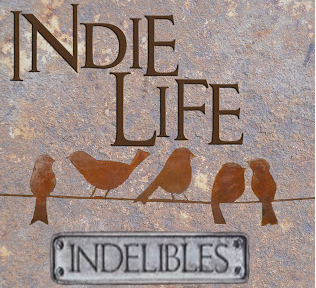
It's been awhile since I wrote about prewriting. I've introduced you to using a story arc and three act structure. This week I want to show you how you can put these two together into a simple format that works well with novels and screenplays.
Syd Field was highly respected in the film industry for teaching the world that screenwriting is a craft. He spent years analyzing screenplays and devised a formula that when used properly helps the screenwriter to create a blockbuster hit. In fact, many of the movies who use his paradigm have gone on to do very well in the theaters. So why am I telling you about a screenwriting technique when you want to write a novel? Because you can use his paradigm to create a bestselling novel.
WARNING: You can only do this if you have already compiled your three act structure and your story arc. If you haven't done so then please go back to the *story arc* and *three act structure* then return to this step.
Step 1: Print off this worksheet. You will need it. http://www.sydfield.com/paradigm.pdf
Grab a pencil and let's take a look at that chart. You will always want to work in pencil when you are plotting your story on a paradigm because you will make changes.

Did you notice that your worksheet is split off into three acts? Since you already know what is going to happen in each act it should be easy to think of your story in each section. Don't write anything yet. We're going to go through this worksheet step by step. We will be working from top to bottom, left to right.
Step 2) In the top box you will want to write a sentence (ONLY ONE) that explains where your protagonist's life is at the start of your story. This is their normal life. Their beginning. The exposition part of your story.
Step 3) Now right below that we want to place the inciting incident. The inciting incident is what happens to the character that disrupts their world. We talk a little bit about this event in my posting about the story arc. You should by now what the inciting incident for your story is. Remember: The inciting incident will create a problem for your character that can not be easily solved and the antagonist will always confront the protagonist in their efforts to gain what they need to solve the problem.
Step 4) Now that we have identified our inciting incident it's time to enter the conflict stage of our story arc. This will start in ACT 1 and not come to a conclusion until the top of ACT 3. Let's talk about plot points for a moment. Readers love plot twists and these are the places to put those.
Plot Point one occurs towards the end of ACT 1. It is the first plot twist of your story. This is the point of no return for your protagonist and is the true starting point of their journey. It is here where they leave their old world behind and set off on their adventure. At the end of their journey they will have a new beginning because the journey will change them. So you need to decide what that one event is that will send your character on his or her way. Once you know what that is write it down in ONE sentence at the bottom of ACT 1.
Step 5) The longest part of your novel will be ACT 2 and is often time the hardest part to write. You want to keep your audience actively engaged with your story. In order to do so you need make certain your every challenge your protagonist faces increases in difficulty. Draw the pinch lines shown in this graphic onto your paradigm. You will be writing a sentence at each step below.

The Pinch points will break up your Act 2 conflict into easier to read sections. It is here you will throw a wrench in your protagonist's plans. These are your plot twists. So if you count them you will in essence have five major plot twists in your story. Use them wisely. If your protagonist's goal changes at any one of these points then you will have to start you story over.
Step 6: Pinch 1
By now the reader clearly knows who your protagonist and antagonist are. The protagonist has a plan to overcome their adversary but we haven't had much of conflict between them since the 1st plot point. Pinch Point 1 is the place where you want to remind the reader that there is an opposing force out there. You want to create an event where the reader and the protagonist are reminded of their struggle. Both pinch and plot points are great for plot twist. Just make certain that they don't completely change your protagonist's goal. If you need a reminder of what your protagonist wants and how it conflicts with the antagonist goals go ahead and write them down. I keep mine next to me while I'm writing so I don't stray too far. Your twist could be a betrayal, the character's path has been cut off, anything. As long as the character's goal never changes. So go ahead and make life a little harder for your protagonist. Make sure it is an obstacle that was harder than Plot Point 1.
Step 7: The Midpoint
You're protagonist has made it to the halfway point of their journey and the stakes have been getting harder for them. Two things should happen at this point of your story.
1) The protagonist should be forced to face their flaws. This could be done in several different ways but it must have the same effect. Usually the protagonist is confronted by the antagonist. The protagonist must come to the realization that they CANNOT continue in their quest without correcting their flaws.
It's a very emotional part of the story.
2) The protagonist breaks down. Their perceived world is shattered and their true essence is exposed. They are venerable and they hate it. But they decide to change for the better so they can defeat the antagonist.
Step 8: Pinch 2
We're getting closer to the climax. The stakes have raised higher and your protagonist is really struggling to meet his or her goal. Just when we are busy watching the protagonist overcome their flaws we are once again reminded of the antagonist. The antagonist will throw the strongest obstacle the protagonist has yet to face at this point. It's another great place for a plot twist.
Step 9: Plot Point 2
You've come along way since the reader was first introduced to your character.
We're finally at the end of Act 2. It's time for another plot twist. Your antagonist is going to create an even harder obstacle for your protagonist but the protagonist will not defeat them. Instead, they will recognize how he or she can ultimately defeat the antagonist after they overcome the obstacle.
Step 10: The Climax
This is where the final battle happens between your protagonist and antagonist. It is the hardest battle your protagonist has ever faced in their life but they are determined to defeat the antagonist. Readers usually do not like to read tragedies so you will need the protagonist to defeat the antagonist once and for all. You don't have to kill the antagonist but you do have to have something happen to him or her in order for the reader to know the entire ordeal is over. You will want to think about this part very carefully because if you plan for your book to be part of a series you don't want to kill the antagonist unless you plan to bring him or her back from the dead.
Step 11: Resolution
We've finally made it to Act 3. The battle is over but the protagonist still has some minor obstacles to face. You generally want three obstacles for them to face in Act 3 as they make their way to their new beginning. Make certain to tie up any loose ends that you have created with your supporting characters. The obstacles you create should be lessening. This is the place of the story where the reader gains closure. Make it a good one and don't leave them hanging.
Step 12: New Beginning
This is the lower box on Act 3. Your protagonist's life has changed and they can never go back to where they started their journey. Sure it may be the same house or the same town but they have changed from the experience. You want to show the readers how the character's world has changed and what their new life looks like. This doesn't need to be too long. Just long enough that your readers feel they can leave the character in a safe place. The world is well and your character life is at new normal.
GREAT JOB ON CREATING YOUR PARADIGM. YOU WILL WANT TO KEEP THIS AS WE WILL BE REFERRING BACK TO IT NEXT TIME WHEN WE EXPLORE THE HERO'S JOURNEY.

It's been awhile since I wrote about prewriting. I've introduced you to using a story arc and three act structure. This week I want to show you how you can put these two together into a simple format that works well with novels and screenplays.
Syd Field was highly respected in the film industry for teaching the world that screenwriting is a craft. He spent years analyzing screenplays and devised a formula that when used properly helps the screenwriter to create a blockbuster hit. In fact, many of the movies who use his paradigm have gone on to do very well in the theaters. So why am I telling you about a screenwriting technique when you want to write a novel? Because you can use his paradigm to create a bestselling novel.
WARNING: You can only do this if you have already compiled your three act structure and your story arc. If you haven't done so then please go back to the *story arc* and *three act structure* then return to this step.
Step 1: Print off this worksheet. You will need it. http://www.sydfield.com/paradigm.pdf
Grab a pencil and let's take a look at that chart. You will always want to work in pencil when you are plotting your story on a paradigm because you will make changes.

Did you notice that your worksheet is split off into three acts? Since you already know what is going to happen in each act it should be easy to think of your story in each section. Don't write anything yet. We're going to go through this worksheet step by step. We will be working from top to bottom, left to right.
Step 2) In the top box you will want to write a sentence (ONLY ONE) that explains where your protagonist's life is at the start of your story. This is their normal life. Their beginning. The exposition part of your story.
Step 3) Now right below that we want to place the inciting incident. The inciting incident is what happens to the character that disrupts their world. We talk a little bit about this event in my posting about the story arc. You should by now what the inciting incident for your story is. Remember: The inciting incident will create a problem for your character that can not be easily solved and the antagonist will always confront the protagonist in their efforts to gain what they need to solve the problem.
Step 4) Now that we have identified our inciting incident it's time to enter the conflict stage of our story arc. This will start in ACT 1 and not come to a conclusion until the top of ACT 3. Let's talk about plot points for a moment. Readers love plot twists and these are the places to put those.
Plot Point one occurs towards the end of ACT 1. It is the first plot twist of your story. This is the point of no return for your protagonist and is the true starting point of their journey. It is here where they leave their old world behind and set off on their adventure. At the end of their journey they will have a new beginning because the journey will change them. So you need to decide what that one event is that will send your character on his or her way. Once you know what that is write it down in ONE sentence at the bottom of ACT 1.
Step 5) The longest part of your novel will be ACT 2 and is often time the hardest part to write. You want to keep your audience actively engaged with your story. In order to do so you need make certain your every challenge your protagonist faces increases in difficulty. Draw the pinch lines shown in this graphic onto your paradigm. You will be writing a sentence at each step below.

The Pinch points will break up your Act 2 conflict into easier to read sections. It is here you will throw a wrench in your protagonist's plans. These are your plot twists. So if you count them you will in essence have five major plot twists in your story. Use them wisely. If your protagonist's goal changes at any one of these points then you will have to start you story over.
Step 6: Pinch 1
By now the reader clearly knows who your protagonist and antagonist are. The protagonist has a plan to overcome their adversary but we haven't had much of conflict between them since the 1st plot point. Pinch Point 1 is the place where you want to remind the reader that there is an opposing force out there. You want to create an event where the reader and the protagonist are reminded of their struggle. Both pinch and plot points are great for plot twist. Just make certain that they don't completely change your protagonist's goal. If you need a reminder of what your protagonist wants and how it conflicts with the antagonist goals go ahead and write them down. I keep mine next to me while I'm writing so I don't stray too far. Your twist could be a betrayal, the character's path has been cut off, anything. As long as the character's goal never changes. So go ahead and make life a little harder for your protagonist. Make sure it is an obstacle that was harder than Plot Point 1.
Step 7: The Midpoint
You're protagonist has made it to the halfway point of their journey and the stakes have been getting harder for them. Two things should happen at this point of your story.
1) The protagonist should be forced to face their flaws. This could be done in several different ways but it must have the same effect. Usually the protagonist is confronted by the antagonist. The protagonist must come to the realization that they CANNOT continue in their quest without correcting their flaws.
It's a very emotional part of the story.
2) The protagonist breaks down. Their perceived world is shattered and their true essence is exposed. They are venerable and they hate it. But they decide to change for the better so they can defeat the antagonist.
Step 8: Pinch 2
We're getting closer to the climax. The stakes have raised higher and your protagonist is really struggling to meet his or her goal. Just when we are busy watching the protagonist overcome their flaws we are once again reminded of the antagonist. The antagonist will throw the strongest obstacle the protagonist has yet to face at this point. It's another great place for a plot twist.
Step 9: Plot Point 2
You've come along way since the reader was first introduced to your character.
We're finally at the end of Act 2. It's time for another plot twist. Your antagonist is going to create an even harder obstacle for your protagonist but the protagonist will not defeat them. Instead, they will recognize how he or she can ultimately defeat the antagonist after they overcome the obstacle.
Step 10: The Climax
This is where the final battle happens between your protagonist and antagonist. It is the hardest battle your protagonist has ever faced in their life but they are determined to defeat the antagonist. Readers usually do not like to read tragedies so you will need the protagonist to defeat the antagonist once and for all. You don't have to kill the antagonist but you do have to have something happen to him or her in order for the reader to know the entire ordeal is over. You will want to think about this part very carefully because if you plan for your book to be part of a series you don't want to kill the antagonist unless you plan to bring him or her back from the dead.
Step 11: Resolution
We've finally made it to Act 3. The battle is over but the protagonist still has some minor obstacles to face. You generally want three obstacles for them to face in Act 3 as they make their way to their new beginning. Make certain to tie up any loose ends that you have created with your supporting characters. The obstacles you create should be lessening. This is the place of the story where the reader gains closure. Make it a good one and don't leave them hanging.
Step 12: New Beginning
This is the lower box on Act 3. Your protagonist's life has changed and they can never go back to where they started their journey. Sure it may be the same house or the same town but they have changed from the experience. You want to show the readers how the character's world has changed and what their new life looks like. This doesn't need to be too long. Just long enough that your readers feel they can leave the character in a safe place. The world is well and your character life is at new normal.
GREAT JOB ON CREATING YOUR PARADIGM. YOU WILL WANT TO KEEP THIS AS WE WILL BE REFERRING BACK TO IT NEXT TIME WHEN WE EXPLORE THE HERO'S JOURNEY.
Published on February 12, 2014 08:20
February 10, 2014
#FREE book. Turn Back Time This Valentine's Day. #kindle #IamReading #love #history
CONTEST!!!
 It's almost time announce the winners. You only have until Thursday to enter into my contest for a free book. All you have to do is leave a comment on any of the Valentine Day's contest posting on my blog. Look for the heart graphic like the one posted here. Winners are announced on Friday.
It's almost time announce the winners. You only have until Thursday to enter into my contest for a free book. All you have to do is leave a comment on any of the Valentine Day's contest posting on my blog. Look for the heart graphic like the one posted here. Winners are announced on Friday.
Today's question:
If you could turn back time who would you want to date and why?
 It's almost time announce the winners. You only have until Thursday to enter into my contest for a free book. All you have to do is leave a comment on any of the Valentine Day's contest posting on my blog. Look for the heart graphic like the one posted here. Winners are announced on Friday.
It's almost time announce the winners. You only have until Thursday to enter into my contest for a free book. All you have to do is leave a comment on any of the Valentine Day's contest posting on my blog. Look for the heart graphic like the one posted here. Winners are announced on Friday.
Today's question:
If you could turn back time who would you want to date and why?
Published on February 10, 2014 06:18
February 9, 2014
#Conspiracy? Who is the real @JohnWilkesBooth? #kindle #History
NEW RELEASE!!!

History teaches us that after John Wilkes Booth assassinated Abraham Lincoln the famed actor was killed at Garrett's Barn in Virginia. Yet there is conflicting evidence that may prove otherwise. Nate Orlowek doesn't believe Wilkes died in the barn that day. If Nate Orlowek is right then we might have to rewrite history. So who died in the barn if it wasn't John Wilkes Booth?http://amzn.to/M1PNQY

History teaches us that after John Wilkes Booth assassinated Abraham Lincoln the famed actor was killed at Garrett's Barn in Virginia. Yet there is conflicting evidence that may prove otherwise. Nate Orlowek doesn't believe Wilkes died in the barn that day. If Nate Orlowek is right then we might have to rewrite history. So who died in the barn if it wasn't John Wilkes Booth?http://amzn.to/M1PNQY
Published on February 09, 2014 07:42



